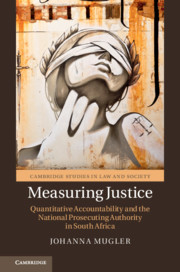 Measuring Justice
Measuring Justice Book contents
- Measuring Justice
- Cambridge Studies in Law and Society
- Measuring Justice
- Copyright page
- Dedication
- Contents
- Acknowledgements
- Abbreviations
- Legislation – Statutes
- Introduction
- I From Apartheid Administrators to Lawyers of the People: A History of Accountability inside the South African Prosecution Authority (1948–2018)
- 2 Ethnographic Research in a Multi-Local Organisation: Access, Challenges and Methods
- 3 ‘Stats Talk’ and Alternative Expressions of Accountability: NPA Lower Court Prosecutors at Work
- 4 No Fear of Numbers: Reactivity and the Political Economy of NPA Performance Measurement
- 5 At the Top of the NPA
- 6 Lies, Damned Lies and Statistics
- Concluding Remarks
- Bibliography
- Index
- Cambridge Studies in Law and Society
5 - At the Top of the NPA
Managing with Numbers and Numerical Reflexivity
Published online by Cambridge University Press: 22 June 2019
- Measuring Justice
- Cambridge Studies in Law and Society
- Measuring Justice
- Copyright page
- Dedication
- Contents
- Acknowledgements
- Abbreviations
- Legislation – Statutes
- Introduction
- I From Apartheid Administrators to Lawyers of the People: A History of Accountability inside the South African Prosecution Authority (1948–2018)
- 2 Ethnographic Research in a Multi-Local Organisation: Access, Challenges and Methods
- 3 ‘Stats Talk’ and Alternative Expressions of Accountability: NPA Lower Court Prosecutors at Work
- 4 No Fear of Numbers: Reactivity and the Political Economy of NPA Performance Measurement
- 5 At the Top of the NPA
- 6 Lies, Damned Lies and Statistics
- Concluding Remarks
- Bibliography
- Index
- Cambridge Studies in Law and Society
Summary
Accountability always involves at least two parties (‘A’ and ‘B’): A, who has been entrusted with authority, discretion and/or money and who has therefore the duty to take responsibility and explain and justify certain actions and decisions to B; and B, who has some form of authority to compel A to act in a particular way and who has the right to ask questions and to demand an account from A about what she did or did not do (Sinclair 1995; Mashaw 2006; Messner 2009). A crucial moment in this relationship is, according to various accountability scholars, that those to whom accountability is to be rendered, have to be convinced – after they received the accounts – that accountability has indeed been rendered. They state that while expectations of how accountability should be demonstrated are never static (Dowdle 2006), they often have a ‘cultural stamp’ (Strathern 2000a: 2).
- Type
- Chapter
- Information
- Measuring JusticeQuantitative Accountability and the National Prosecuting Authority in South Africa, pp. 117 - 139Publisher: Cambridge University PressPrint publication year: 2019
